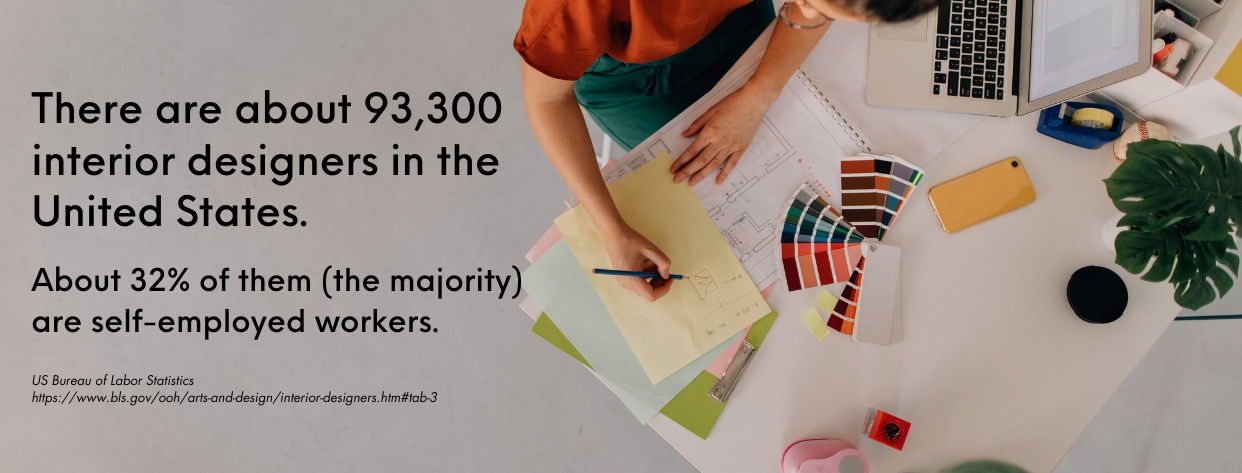Interior design is a dynamic field that aspires to craft spaces that are harmonious and functional and a true reflection of the people who inhabit them. In 2023, the demand for human-centered interior design has soared as individuals seek solace and connection within their living environments.
Let’s explore the essential steps to embark on a successful interior design career that prioritizes the human experience, incorporating elements of empathy, sustainability, and cutting-edge technology.
Meaningful Spaces: A Journey in Interior Design
Come explore the fascinating world of interior design, where boundless creativity and your deep passion for creating meaningful spaces propel you on a thrilling journey of constant growth and transformation. This dynamic industry keeps expanding, and you’ll discover that your love for design transcends mere aesthetics; it’s all about crafting interior spaces that deeply resonate with the unique essence of each individual who calls them their own.
As you embark on your interior design career, your exceptional talent for attentive listening and wholeheartedly immersing yourself in your client’s stories will play a pivotal role. You eagerly soak in their desires, dreams, and cherished memories, understanding the emotions they yearn to experience within the walls of their space. It’s not just about the physical elements like materials and colors; what truly matters to you is connecting with their hearts.
As you dive into every new project, you’re continually reminded of the profound effect interior design can have on people’s lives. The real happiness and contentment your clients feel when you unveil their transformed spaces become your most cherished rewards in this ever-evolving world of interior design—a world where your creativity, understanding, and enthusiasm radiate, leaving a lasting impression on the hearts of all you connect with.
Interior Design Passion: Explore, Create, and Inspire

Discovering your interior design passions is a thrilling journey of self-exploration and creative discovery. It’s about following your instincts, experimenting with spaces, and uncovering what truly sparks joy in your design endeavors.
Whether you’re making cozy and inviting living rooms, creating sleek and modern spaces as kitchen and bath designers, or infusing eclectic and vibrant aesthetics, interior design jobs present an adventure that is uniquely yours to embrace and enjoy!
All interior design careers enable you to discover the true art of crafting interior spaces that transcend mere aesthetics—they become personalized sanctuaries, speaking to the very essence of each individual.
Aspiring interior designers like you need to embrace the beauty of design, allowing your creativity to soar, and relish every moment as you unveil the enchantment of your interior design passions. Throughout this journey, inspiration will find you in various interior design elements, while learning from experienced interior designers will empower you and build your confidence.
Each design process will transform to become your canvas, offering an opportunity to express your distinctive vision and create spaces that reflect your heart and soul. So, dive into this artistic adventure, cherishing every step, and let the magic of interior design ignite your spirit as you craft spaces that truly resonate with your essence.
The Roles and Job Opportunities of Interior Design
Interior designers are imaginative experts who focus on creating and enhancing interior spaces that are practical, visually pleasant, and in line with the client’s demands and preferences. With their vast knowledge of art, architecture, and spatial planning, they manage the design elements, oversee construction, and ensure that project objectives are met.
Interior designers can typically turn ordinary spaces into truly captivating environments. Interior designers collaborate closely with clients to understand their vision, lifestyle, and budget and then conceptualize design plans that encompass layout, furniture selection, color schemes, lighting, and decorative elements.
Interior design extends beyond aesthetics; they also focus on functionality and practicality. They consider factors such as spatial flow, safety regulations, and accessibility to design spaces that are beautiful but also efficient and user-friendly.
Interior designers work in various industries, offering diverse job opportunities. Some of the common career paths for interior designers include:
Residential Interior Designers
These designers specialize in designing and beautifying homes, apartments, and private residences, crafting customized and cozy living spaces.
Commercial Interior Designers
Commercial interior design concerns projects for commercial spaces like offices, retail stores, and restaurants to make interior spaces functional and visually appealing environments that cater to business needs.
Hospitality Interior Designers
Hospitality interiors must create a captivating and immersive guest experience. Specialists are equipped with the tools to design hotels, resorts, restaurants, and various other hospitality venues.
Healthcare Interior Designers
Healthcare interiors must be designed in a way that they provide therapeutic and comforting environments for hospitals, clinics, and healthcare facilities to enhance the well-being of patients and staff.
Corporate Interior Designers
Corporate interior designs must promote productivity, collaboration, and employee well-being.
Sustainable Interior Designers
Sustainable interiors are eco-friendly and environmentally conscious designs, utilizing sustainable materials and practices to minimize the environmental impact of projects.
Exhibition and Event Designers
Event and exhibition design specialists create impactful and captivating temporary venues for exhibitions, trade shows, and events.
Freelance or Self Employed Interior Designer
Self-employed interior designers work freely and accept projects from multiple clients, allowing flexibility and freedom in design choices.
Set Designers
Set designers must create sets for television, movies, and theater to create particular emotions and atmospheres.
Fashion Designers
Fashion designers are creative people who design clothing and accessories professionally, drawing inspiration from various sources. They work with fabrics and materials to bring their ideas to life and showcase their collections through fashion shows or presentations. Fashion designers need technical skills, business acumen, and a keen eye for trends to succeed in the industry. Their work influences the way people dress and express themselves through fashion.
Interior designers are instrumental in shaping our spaces, adding beauty, functionality, and innovation to our surroundings. Interior designers produce a design that satisfies their client’s wants and functional spaces. They have a versatile skill set and diverse career opportunities, making the interior design profession rewarding for those with a passion for creativity and a flair for design.
Let’s Talk Money: The Financial Opportunities in Interior Design

If you’re curious about how much an interior designer typically earns, some important factors come into play. Experience is a major one – as interior designers gain more years of practice and education, their salary tends to increase.
Additionally, your earnings are affected by the projects you work on and the size of your workplace. The types of interior design projects you take on and the extent of your responsibilities directly influence your salary in this profession. Interior designers must grasp the significance of these factors in influencing their income.
Federal data show that interior designers in the US earn an annual salary of $59,107. The average salary for interior designers can range from $15,000 to $132,000 annually, with a median annual wage of around $56,040. However, it’s important to note that interior designer salaries can range from lower to higher figures. Those in the lowest 10% of earnings made around $31,970 for their interior design project, while the highest 10% earned more than $96,470 annually.
Most interior designers working in metropolitan areas or regions with higher living costs typically receive higher pay than those in smaller towns or less populated regions. Similarly, interior designers with extensive experience, specialty, and a successful history of satisfied clients often earn more than newcomers to the interior design industry.
Registered interior designers and self-employed interior designers who own interior design businesses and operate as independent professionals or own their design firms make more money, depending on the success of the interior design business and the scale of their projects. Becoming an interior designer can present financial prospects, especially for individuals who possess passion, exceptional skills, and a steadfast dedication to their craft.
The Power of Education in Interior Design
Education is vital to shaping your creative journey when pursuing a career in interior design. Enrolling in interior design programs or courses equips you with essential technical skills and helps unleash your artistic potential and unique style. You can learn from licensed designers who share their insights, sparking inspiration and guiding you. Also, It is a requirement that interior designers must have an Interior Design degree, particularly a bachelor’s degree and a master’s degree.
One of the significant benefits of proper education is exposure to diverse design concepts and trends. To become an interior designer, obtaining the right training and education lets you stay on top of the latest innovations and industry practices. The knowledge gained during your interior design education empowers you to approach each project with confidence and a solid foundation. Moreover, through your interior design classes, you’ll be introduced to various computer-aided design software and tools, such as an online interior design program that makes you proficient in translating your ideas into impressive visual presentations.
Also, it makes you create three-dimensional visualizations that help you create drawings, whether indoor spaces. Combining technical skills and artistic expression sets the stage for turning your creativity into reality. While education is essential for your interior design career, its advantages go beyond mere academic learning. It cultivates discipline, time and project management, and problem-solving abilities, all of which are invaluable assets in your professional journey.
Furthermore, having a degree in interior design opens doors to networking opportunities and connections with fellow designers and industry professionals. Building a support network inspires collaboration and opens doors to potential job opportunities and partnerships. The education you receive becomes a source of continuous learning. Even as you enter the professional field, your journey of growth, exploration, and skill refinement continues as you face diverse projects and overcome various challenges.
In summary, interior design education imparts technical know-how, nurtures your passion, fosters creativity, and connects you with a community of like-minded individuals. It’s a lifelong learning, discovery, and growth journey, ultimately shaping you into a well-rounded and successful interior designer.
Interior Design Job Outlook

Interior designers produce designs that demonstrate their passion for design and shape personalized and joyful spaces. Your career will be a dynamic and fulfilling adventure, collaborating with diverse and new clients and turning creative ideas into reality.
In this profession, you can explore various design styles and techniques, infusing your personality and artistic flair into each project. From selecting the perfect color palettes to sourcing the most exquisite furnishings, your work involves a delightful mix of creativity and problem-solving.
The connections you forge with clients, fellow licensed and unlicensed designers, and industry experts form a supportive and uplifting community. In interior design, you pursue your passion while making a meaningful impact.
The job outlook for interior designers is promising, with a world of opportunities awaiting those passionate about creating beautiful and functional spaces. As cities expand and people continue to value personalized environments, the demand for skilled interior designers is rising.
8 Steps to a Thriving Interior Design Career in 2023
Entering the realm of interior design is akin to stepping into a magical world where your love for design becomes your driving force. It’s a captivating journey of passion, creativity, and endless possibilities, and there are steps to guide you along this enchanting path:
- Embrace empathy. Empathy is the foundational trait that transforms spaces into meaningful sanctuaries. You must learn to understand your clients’ desires and identify their emotional needs to connect with them deeper to help you create a space that resonates with them.
- Cultivate a diverse skill set. To excel as an interior designer, one must possess a dynamic range of skills that blend imagination, technical prowess, and the ability to tackle challenges head-on. You must be well-rounded in space planning, color theory, electrical and partition layouts, material selection, and sustainable practices. Moreover, having a strong command of cutting-edge design software and digital visualization tools empowers you to convey your creative ideas effectively.
- Focus on sustainable design. When you embrace sustainability as a core value, you showcase your dedication to the welfare of your clients and the environment.
- Stay updated on technological advancements. Technology rapidly transforms the interior design landscape. Interior designers must embrace these cutting-edge technologies to create immersive and interactive designs, such as computer-aided designs that cater to clients’ preferences.
- Foster collaborative partnerships. A human-centered approach to interior design requires collaboration with clients and other professionals in the interior design industry. This enhances your ability to deliver exceptional results and create human-oriented spaces.
- Develop a unique design philosophy. A clear and unique design philosophy enables you to create spaces that deeply connect with people and enhance their sense of belonging and well-being.
- Build an online presence. To gain visibility, develop an online interior design portfolio and interior design resume, stay active on social media, and interact with design communities. Sharing your design process and the basic principles of human-centered design might help you draw in new clients and partners.
- Seek professional certifications. Obtaining relevant certifications adds credibility to your career. An interior design certificate demonstrates your commitment to upholding industry standards and staying informed about the latest advancements and best practices.
Getting Certified
Becoming a certified interior design professional opens possibilities where creativity meets expertise, and passion shapes meaningful spaces. Only licensed designers are allowed to practice in most states, and the requirements vary. A licensed interior designer gets the chance to hone their skills, expand their knowledge, and earn the recognition that empowers them to bring dreams to life.
With certification, you’ll unlock new opportunities, build trust with clients, and showcase your dedication to excellence in the dynamic world of interior design. So, step into this transformative path, and let your journey as a certified interior design professional begin!
Listed down below are some of the Interior Design Certifications:
- National Council for Interior Design Qualification (NCIDQ)
- International WELL Building Institute (IWBI)
- Leadership in Energy and Environmental Design (LEED)
- American Lighting Specialists (ALA)
- American Academy of Healthcare Interior Designers (AAHID)
- National Association of Home Builders (NAHB)
- National Association of the Remodeling Industry (NARI)
- National Kitchen and Bath Association (NKBA)
Unleashing Your Success through Networking in Interior Design

Networking and industry involvement are essential for your success in the captivating world of interior design. Connecting with fellow designers and professionals, attending events, and actively engaging in the design community, you unlock doors to thrilling opportunities and build genuine relationships. These connections inspire growth, expand your creativity, and lead to a fulfilling career in this dynamic field.
Networking opens doors to valuable insights, idea exchange, and collaborative projects that push and enrich your skills in interior design. Building a strong network expands your connections and offers the support and inspiration necessary to flourish in your interior design career. Embrace the power of networking as it fuels your passion for interior design, propelling you to reach new heights on an exhilarating journey of learning, discovery, and endless possibilities.

Empowering Growth Through Constructive Criticism
Criticism is essential to the development and improvement of creative endeavors in the field of interior design. Embracing constructive criticism is vital for designers to foster personal growth and elevate their creative output. Maintaining an open mind and being willing to learn is crucial when receiving constructive criticism. Viewing this as a chance to grow and learn new things would do you more good than viewing this as a defeat.
One can learn where one can make changes, receive feedback, and be motivated to take creative risks through constructive criticism. Accepting criticism with grace and maturity creates a climate where people are willing to work together, and new ideas and improved concepts can develop. We turn constructive criticism into an effective instrument for survival in the dynamic field of interior design by listening to and acting on the feedback of our peers.
Is Interior Design Your True Calling?
Every person’s life is a remarkable journey full of exciting opportunities for growth and discovery. During our journey, we have the incredible opportunity to discover the passions that truly ignite the fire within us. These passions act as a key, unlocking the door to a world filled with marvelous wonders waiting to be explored.
If you think you have what it takes for boundless creativity and personal expression in interior design, this will help you start on your true calling. Embarking on this thrilling journey will help you uncover whether this path resonates with your truest essence, guiding you toward self-discovery and personal fulfillment.
If you possess these qualities, Interior Design might be for you:
You have the creative urge.
Interior design is a playground for creativity where your imagination can run wild. If you have a natural flair for aesthetics and love to express yourself through art, interior design could be a fulfilling outlet for your creative urges.
You find beauty in practicality.
Interior design goes beyond mere aesthetics and delves into the realm of functionality. It’s about making a space that captivates the eye and serves its importance seamlessly. If you enjoy problem-solving and are passionate about creating stylish and elegant spaces, the interior design industry could be right up your alley.
You are detail-oriented and patient enough to perfect the finer points.
Interior design is a captivating realm where every little detail holds immense significance. Do you possess a sharp eye for intricate details? Do you have the patience to refine every element? Do you enjoy the seamless fusion of colors, textures, and proportions? Interior design might be perfect for you!
You have empathy and listening skills.
Interior designers must be skilled listeners and possess the ability to empathize with clients’ desires and visions for their spaces. If you enjoy working closely with people, understanding their preferences, and translating their dreams into tangible designs, you have a vital quality needed to excel in interior design.
You adapt easily and seek continuous learning.
Interior designers work in a dynamic field that is constantly evolving with new trends, materials, and technologies. Many interior designers embrace change and are eager to learn and adapt to new techniques and styles. Interior designers read blueprints, so you must be adept at that. If you thrive in a constantly evolving environment and see every challenge as an opportunity to grow, interior design could offer the exciting, ever-changing career you seek.
You work hard to turn vision into reality.
The joy of witnessing a transformation come to life is one of the most rewarding aspects of interior design. If you have a passion for turning a blank canvas into a functional, aesthetically pleasing, and personalized space that brings joy to others, then interior design might be the fulfilling career you’ve been searching for.
Unlocking the Designer Within

Interior design is an exciting realm with endless possibilities for unleashing your creativity and self-expression. It is an exhilarating voyage of self-discovery and fulfillment, where every step unveils a world brimming with awe-inspiring wonders just waiting to be explored. As an interior designer, you see empty rooms transformed into welcoming, comfortable, and uniquely living quarters.
Unlock the designer within, embrace your creative urges, and embark on a journey of discovery to uncover if interior design is your perfect fit. It’s a world of enchantment where your passion and dedication will shape spaces that resonate with the essence of those who inhabit them.
Let the magic of interior design ignite your spirit as you craft spaces that leave an everlasting impression on hearts and minds. The adventure awaits, and the world of interior design beckons you to unleash your true potential and embrace the beauty of making meaningful spaces.
For more valuable information, see the following:

